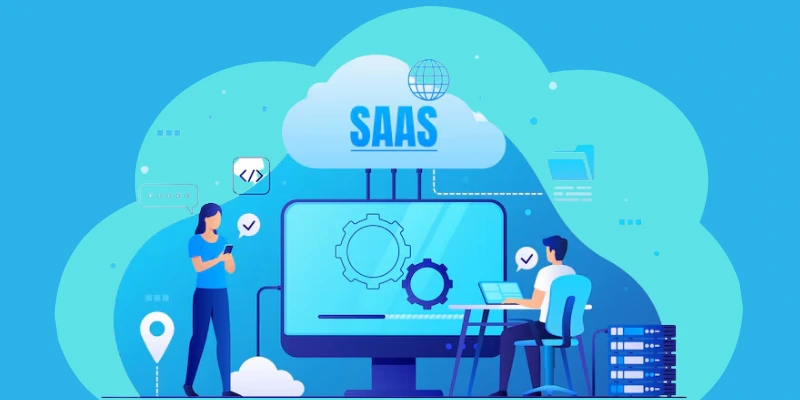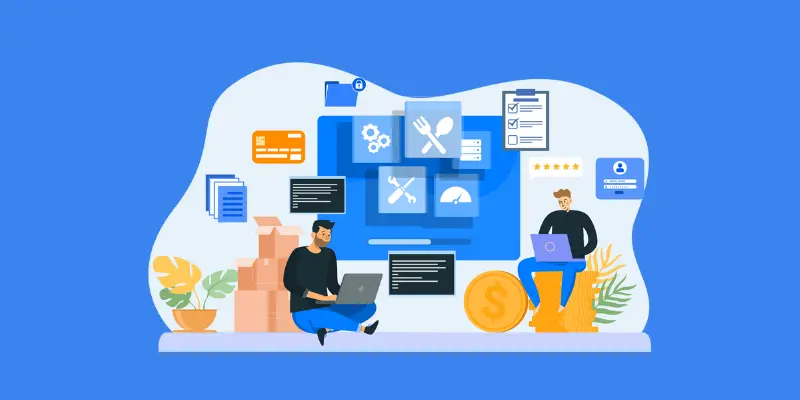Why did the cloud application break up with its local server? Because it needed more space! In the world of cloud app development, scalability is not just a luxury; it's a necessity. Businesses today must adapt quickly to changing demands, and cloud-based applications offer the perfect solution by operating entirely in the cloud rather than relying on local servers or personal devices. This shift allows organizations to harness the power of remote data servers, enhancing both performance and scalability.
Cloud-based applications have many benefits, including their affordability, simplicity of access, and capacity to incorporate cutting-edge technology supporting expansion. Using cloud services helps companies rapidly meet consumer needs and properly allocate their resources.
Emphasizing the need for strategic planning, technological integration, and continual review to guarantee sustainable development in an always-changing terrain, this article describes the main stages of developing a scalable cloud-based app.
Read Also: Complete Guide on Models to Hire Software Developers
Understanding Scalability
Scalability in the context of cloud-based applications refers to the capacity of a system to react to changing workloads by adding or lowering its resources as applicable. This flexibility is important for companies that face changing needs, enabling them to improve performance and prices without large infrastructure expenditures.
There are two basic forms of scalability: vertical scaling (scaling up) and horizontal scaling (scaling out).
Vertical scaling means adding additional power (such as CPU or RAM) to existing servers, whereas horizontal scaling includes adding more servers to disperse the load properly over different nodes.
-
The need for scalability is vital for corporate expansion and sustaining excellent performance in cloud applications.
-
A scalable cloud application can withstand unexpected increases in traffic without deterioration in service, delivering a favorable user experience.
-
This flexibility enables ongoing operational efficiency and helps organizations respond promptly to market developments, making scalability a component of competitive advantage.
Several key variables impact the scalability of cloud systems, including:
-
Architecture: A well-designed architecture, such as a distributed system or microservices, provides efficient resource allocation and avoids bottlenecks.
-
Resource Management: Effective resource management ensures that processing power and storage are utilized properly.
-
Workload Allocation: Workload distribution enables workloads to be split across numerous servers, boosting performance and dependability.
By understanding and adopting these essential aspects, organizations can develop powerful cloud applications that scale smoothly with their demands.
Implementing scalability strategies not only prepares businesses for growth but also enhances their ability to adapt to changing market conditions, ensuring sustained growth and success.
Scalability in Cloud Application Development: Key Principles and Best Practices
1. Choosing the Right Cloud Platform
Choosing the correct cloud platform is important for businesses that want to cloud-based app development efficiently. Understanding the different cloud service models is the first step in this approach.
Overview of Cloud Service Models
-
Infrastructure as a Service (IaaS): This concept delivers virtualized computer resources via the Internet. Users may rent servers, storage, and networking capabilities, giving for tremendous flexibility and control. Google Cloud's Compute Engine is a great example, allowing customers to run virtual computers and scale resources depending on demand.
-
Platform as a Service (PaaS): PaaS provides a platform enabling developers to design, deploy, and maintain applications without dealing with the underlying infrastructure. This architecture simplifies development processes and boosts productivity by offering built-in tools and services.
-
Software as a Service (SaaS): SaaS distributes software programs via the Internet on a subscription basis. Users may use these apps from any device with an internet connection, making them handy and cost-effective for enterprises.
Evaluating Cloud Providers
When picking a cloud provider such as AWS, Azure, or Google Cloud, various considerations should be considered:
-
Performance and Scalability: Assess how effectively the platform can manage growing demands.
-
Security Features: Evaluate the security mechanisms in place to safeguard data.
-
Cost Structure: Understand pricing methods to ensure they correspond with your budget.
-
Support and Documentation: Check the availability of customer support and thorough documentation.
Is Google Cloud Scalable?
Google Cloud distinguishes itself for its excellent scalability characteristics. It features autoscaling, which automatically raises the number of virtual machine instances based on load, promising maximum speed during traffic spikes while lowering expenses during low-demand times.
Additionally, Google Cloud’s global load balancing sends traffic to the closest open instance, improving both speed and dependability.
Case Studies
Several firms have successfully picked the proper platform and grown efficiently. For instance, a renowned e-commerce business employed Google Cloud’s autoscaling features to accommodate seasonal traffic spikes without sacrificing user experience. Similarly, a software firm exploited AWS’s flexible IaaS capabilities to extend its infrastructure swiftly as its user base increased from hundreds to thousands within months.
By knowing these elements of cloud platforms, organizations can make educated selections that correspond with their growth objectives and operational demands.
2. Designing for Scalability
Designing for flexibility is crucial in cloud settings to ensure that cloud-based apps can handle growing loads and adapt to changing demands. One successful method is using microservices design, which breaks down systems into smaller, separate services that can be grown individually.
This simplicity allows businesses to react quickly to user demands, as each service can be created, launched, and grown independently without affecting the entire system. Additionally, microservices improve failure separation; if one service breaks, the others continue to function, improving total reliability.
When it comes to cloud-based software development, best practices for building scalable databases range between NoSQL and SQL databases.
-
NoSQL databases are often chosen for their ability to handle large amounts of unorganized data and horizontal growth capabilities, making them ideal for many cloud-based apps.
-
They allow for flexible system designs and can spread data across various computers quickly. In comparison, SQL databases offer strong stability and complex searching capabilities but may require vertical growth, which can lead to limits as demand grows.
Organizations should consider their specific needs and choose the database type that best serves their growth goals.
Load balancing plays an essential role in spreading traffic across multiple computers within a chosen cloud platform, ensuring no single server becomes overwhelmed. By successfully handling incoming requests, load balancers keep application speed and availability during busy usage times.
To build for growth in cloud systems, several concepts should be considered:
-
Decentralization: Avoid centralized data handling to avoid bottlenecks.
-
Auto-scaling: Implement auto-scaling features that change resources based on real-time demand.
-
Monitoring: Utilize thorough tracking tools to track performance data and spot possible problems before they impact users.
By sticking to these design principles, organizations can build flexible cloud-based software development solutions that meet both current and future needs effectively.
Companies looking to improve their skills may consider hiring specialized developers or a respectable cloud-based software development company that specializes in offering complete cloud-based software development services. This strategy method ensures successful cloud app creation, allowing companies to thrive in a competitive setting.
3. Development Best Practices
Implementing effective cloud-based app development techniques is important for improving the scale and efficiency of apps. By following best practices, organizations can ensure their applications are sturdy, flexible, and capable of meeting future demands.
Agile Methodology
One of the most effective methods for cloud-based app development is Agile development. This method supports rapid progress and flexibility, allowing teams to change quickly to changing needs and user input. Agile allows easier growth of applications as new features are added or old ones are changed.
Benefits of Agile:
-
Encourages continuous growth and freedom.
-
Allows quick change to changing needs.
-
Facilitates easy growth of apps.
API-First Approach
An API-first method is another important practice in cloud-based software development. By choosing API design before the code starts, developers can create consistent and useful interfaces that aid future scaling. This approach ensures that as the application grows, its components can interact effectively without needing extensive rework.
Importance of API-First:
-
Ensures consistent and useful interfaces.
-
Facilitates future growth of apps.
-
Reduces the need for extensive rework as the service changes.
Continuous Integration/Continuous Deployment (CI/CD)
Utilizing Continuous Integration/Continuous Deployment (CI/CD) techniques greatly helps scalable apps. CI/CD simplifies testing and publishing processes, allowing teams to make changes frequently and accurately. This not only speeds time-to-market but also ensures that any growth issues are handled quickly, keeping ideal performance under different loads.
Benefits of CI/CD:
-
Automates testing and release steps.
-
Enables fast and accurate changes.
-
Addresses scalability problems quickly.
Scalability Techniques
Various scaling methods can be applied in cloud apps to improve efficiency. Techniques such as load balancing, which spreads incoming traffic across various computers, and auto-scaling, which automatically changes resources based on real-time demand, are important for keeping application speed.
Key Scalability Techniques:
-
Load Balancing: Distributes data across various computers to avoid overload.
-
Auto-Scaling: Adjusts resources automatically based on real-time demand.
-
Microservices Architecture: Allows separate growth of program components.
By combining these best practices into their development processes, organizations can ensure their cloud-based software development services deliver flexible solutions that effectively meet both current and future demands. Companies looking to improve their skills should hire software developers who specialize in these methods to maximize their cloud app development potential.
4. Monitoring and Optimization
Effective tracking and tuning are important for keeping the speed and flexibility of cloud-based apps. Utilizing tracking tools helps companies gain insights into application speed and spot possible problems.
Monitoring Tools
Tools such as New Relic and Datadog provide thorough views into application speed. They help track key data in real-time, allowing teams to effectively solve problems before they harm users.
Key Features:
-
Real-time info on computer health and reaction times.
-
Identification of bottlenecks and speed problems.
-
User engagement tracking for better insights.
Performance Optimization
As user demand grows, improving speed becomes important. Various strategies can be applied to ensure that applications stay quick and efficient.
Optimization Strategies:
-
Implement efficient methods to enhance working speed.
-
Optimize database queries to reduce delay.
-
Utilize cache techniques to decrease load times.
-
Proactive resource control to handle higher traffic effectively.
Feedback Loops
Collecting user feedback is important for ongoing growth. Establishing feedback loops helps companies gather information directly from users about their experiences.
Importance of Feedback:
-
Essential for making continuous changes to the program.
-
Provides user data that helps improve features.
-
Enhances general application speed based on real user experiences.
By focusing on these areas, companies can ensure their cloud-based software development services offer high-performing apps that grow effectively with user demand.
5. Security Consideration
Data Security
In the world of cloud-based apps, ensuring data protection is important. Implementing security best practices involves utilizing encryption, enforcing strict access controls, and regularly updating security measures to protect private information.
Organizations should adopt a shared-duty model where both the cloud service and the customer are responsible for security steps.
Key Practices:
-
Utilize encryption to protect private info.
-
Enforce tight access rules to limit illegal entry.
-
Regularly update security methods to address weaknesses.
-
Adopt a shared duty plan for improved security.
Compliance and Regulations
Adhering to safety laws, such as GDPR and HIPAA, is crucial for businesses working in controlled industries. Compliance not only helps avoid legal fines but also builds trust with customers by showing a commitment to data safety. You should hire dedicated developers to make sure you adhere to these safety laws.
Importance of Compliance:
-
Adhere to business laws like GDPR and HIPAA.
-
Avoid civil fines through cooperation.
-
Build customer trust by showing a commitment to data safety.
Risk Management
Effective risk management strategies are important for handling possible threats in a scalable cloud setting. This includes performing regular risk reviews to spot weaknesses, implementing powerful tracking tools for event detection, and ranking risks based on their possible effect
Risk Management Strategies:
-
Conduct regular risk reviews to find weaknesses.
-
Implement powerful tracking tools for prompt incident discovery.
-
Prioritize risks based on their possible effects for effective resource allocation.
By focusing on these security considerations—data security best practices, adherence to compliance regulations, and proactive risk management—organizations can enhance the protection of their cloud-based software development services and ensure the integrity of their applications in a scalable environment.
Choose JPLoft for Your Cloud App Development Needs!
Unlock the potential of your business by working with JPLOft, a top custom software development company focusing on cloud app development. Our expert team is committed to making new solutions suited to your unique needs. With vast knowledge across various industries, we guarantee that your applications are not only flexible but also safe and high-performing.
Don’t wait—embrace flexibility today! Contact JPLoft to turn your ideas into reality and push your business forward with cutting-edge technology solutions. Let’s build a better future together!
Conclusion
In summary, adopting flexibility is important for companies trying to succeed in today's competitive environment. Key steps discussed include adopting effective cloud-based app development practices, utilizing tracking tools to track performance, and ensuring strong security measures are in place.
Additionally, choosing an Agile methodology, applying an API-first approach, and integrating user comments can greatly improve application speed.
By focusing on these tactics, organizations can effectively meet growing user expectations and react to changing market conditions.












Share this blog